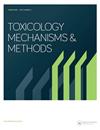多巴胺D2/D5受体拮抗剂盐酸莫吲哚酮对幼年和成年大鼠的毒性评估
IF 2.7
4区 医学
Q2 TOXICOLOGY
引用次数: 4
摘要
摘要盐酸莫林酮是一种多巴胺D2/D5受体拮抗剂,用于治疗注意力缺陷/多动障碍(ADHD)儿童和青少年的冲动攻击,目前处于开发后期。这种药物的新适应症将扩大目标人群,将年轻患者包括在内,因此,对幼年动物进行了毒性评估,以确定该年龄组和成年大鼠之间的易感性差异(如果有的话)。成年大鼠以0、5、20或60的剂量水平经口灌胃给予莫吲哚酮13周 毫克/千克体重/天。幼年大鼠经口灌胃给药8周,剂量水平为0、5、25、50或75 毫克/千克体重/天。在与美国食品药品监督管理局协商后,使用相关研究设计进行了标准毒理学评估。在两个年龄组中都观察到与治疗相关的血清胆固醇和甘油三酯升高以及葡萄糖水平下降。器官重量的变化包括肝脏、肾上腺和精囊/前列腺重量的增加。在暴露于前两个剂量且暴露量足够的成年女性中,子宫重量也有所下降。在青少年中,观察到了继发于体重下降的性成熟参数,但发生了逆转。总之,在成人生殖组织中发现的不良反应归因于高泌乳素血症,由于生殖激素调节的物种差异,这些变化被认为与人类无关。总的来说,两个年龄组之间的药物毒性特征没有显著差异。本文章由计算机程序翻译,如有差异,请以英文原文为准。
Toxicity assessment of molindone hydrochloride, a dopamine D2/D5 receptor antagonist in juvenile and adult rats
Abstract Neuroleptic drug molindone hydrochloride is a dopamine D2/D5 receptor antagonist and it is in late stage development for the treatment of impulsive aggression in children and adolescents who have attention deficient/hyperactivity disorder (ADHD). This new indication for this drug would expand the target population to include younger patients, and therefore, toxicity assessments in juvenile animals were undertaken in order to determine susceptibility differences, if any, between this age group and the adult rats. Adult rats were administered molindone by oral gavage for 13 weeks at dose levels of 0, 5, 20, or 60 mg/kg-bw/day. Juvenile rats were dosed for 8 weeks by oral gavage at dose levels of 0, 5, 25, 50, or 75 mg/kg-bw/day. Standard toxicological assessments were made using relevant study designs in consultation with FDA. Treatment-related elevation in serum cholesterol and triglycerides and decreases in glucose levels were observed in both the age groups. Organ weight changes included increases in liver, adrenal gland and seminal vesicles/prostate weights. Decreases in uterine weights were also observed in adult females exposed to the top two doses with sufficient exposure. In juveniles, sexual maturity parameters secondary to decreased body weights were observed, but, were reversed. In conclusion, the adverse effects noted in reproductive tissues of adults were attributed to hyperprolactinemia and these changes were not considered to be relevant to humans due to species differences in hormonal regulation of reproduction. On the whole, there were no remarkable differences in the toxicity profile of the drug between the two age groups.
求助全文
通过发布文献求助,成功后即可免费获取论文全文。
去求助
来源期刊

Toxicology Mechanisms and Methods
TOXICOLOGY-
自引率
3.10%
发文量
66
期刊介绍:
Toxicology Mechanisms and Methods is a peer-reviewed journal whose aim is twofold. Firstly, the journal contains original research on subjects dealing with the mechanisms by which foreign chemicals cause toxic tissue injury. Chemical substances of interest include industrial compounds, environmental pollutants, hazardous wastes, drugs, pesticides, and chemical warfare agents. The scope of the journal spans from molecular and cellular mechanisms of action to the consideration of mechanistic evidence in establishing regulatory policy.
Secondly, the journal addresses aspects of the development, validation, and application of new and existing laboratory methods, techniques, and equipment. A variety of research methods are discussed, including:
In vivo studies with standard and alternative species
In vitro studies and alternative methodologies
Molecular, biochemical, and cellular techniques
Pharmacokinetics and pharmacodynamics
Mathematical modeling and computer programs
Forensic analyses
Risk assessment
Data collection and analysis.
 求助内容:
求助内容: 应助结果提醒方式:
应助结果提醒方式:


